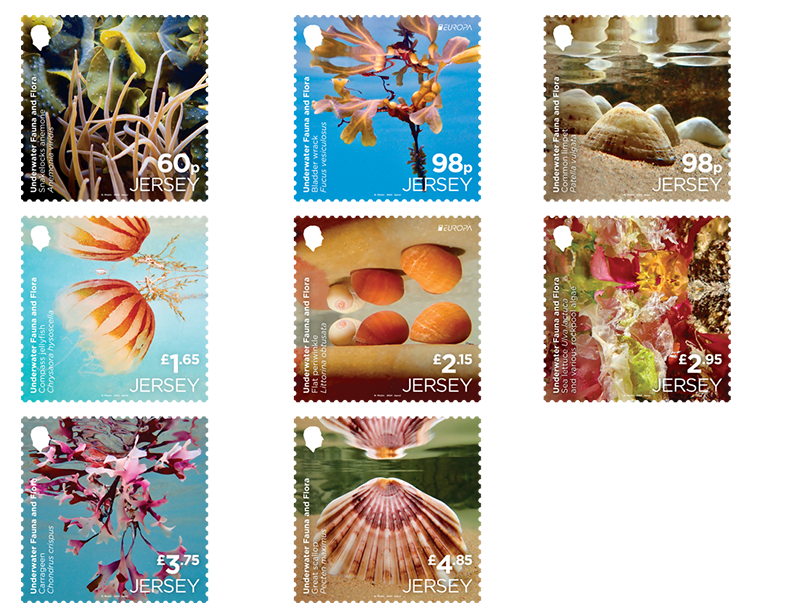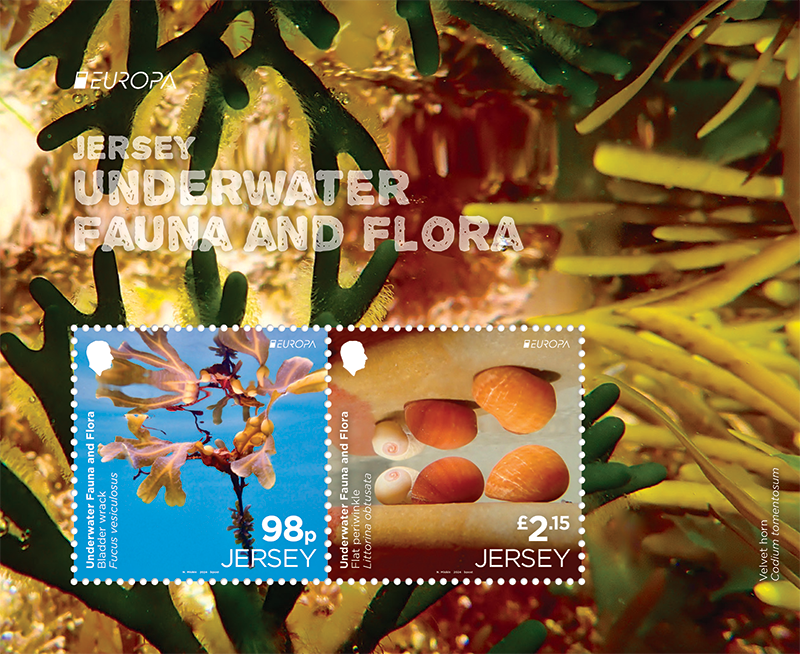Jersey Post Release Europa Underwater Stamp Issue
December 19, 2023

Jersey Post will release a new stamp issue on the 8th January 2024 as part of the 2024 Europa series celebrating the underwater environment, entitled ‘Europa: Underwater Fauna and Flora’.
The trade association known as ‘PostEurop’ established in 1993 to represent the interests of European public postal operators. Each year a theme is set for jurisdictions to interpret with the aim of building awareness of the common roots, culture and history of Europe. For 2024, the theme Underwater Fauna and Flora has been selected.
The issue features images from around Jersey’s coastline, taken by local underwater photographer and cold water swimmer, Nicola Miskin. Nicola describes her work, “Swimming in the sea all year round, photographing underwater opened my eyes to a beautiful world. The ever-changing sea is a studio of colours, patterns and reflections.”
Nicola’s love of underwater photography started in 2018 when she was given a worn underwater camera which she used to master the art of taking beautiful photographs whilst being buffeted by the currents. Harnessing the natural light from the water’s surface, the images showcase a vibrant under-water world hidden from view around the Island.

The stamp issue contains some of the most common underwater fauna and flora found in our bays including Snakelocks anemone (60p stamp), Bladder wrack (1st 98p stamp), Common limpet (2nd 98p stamp), Compass jellyfish (£1.65 stamp), Flat periwinkle (£2.15 stamp), Sea lettuce (£2.95 stamp), Carrageen (£3.75 stamp), Great scallop (£4.85 stamp) and Velvet Horn featured on the souvenir miniature sheet.
Snakelocks anemone 60p, this type of fauna lives attached to rocks which are found within low shore and show seas about 12m. Their name derives from having snake-like tentacles, which are usually a bright green with purple tips. It's common for them to be home to algae, which produces energy from sunlight.
Bladder wrack 98p (1), a type of common seaweed, which grows between the high and low water marks within rocky shores. They feature round air bladders, which is what allows the seaweed to float upright while underwater. Many underwater fauna also use bladder wrack as a type of food source.
Common limpet 98p (2), often seen firmly clamped along the side of rockpools, common limpets tend to remain unmoving, that is until the tide comes in. Once the tide is up, common limpets, which have cone-like shells, will begin moving around the rocks to eat algae using a tough tongue. In fact, limpet tongues are known to have the world’s strongest biological structure.
Compass jellyfish £1.65, get the name due to their distinctive markings. These jellyfish usually gift Jersey shores with their presence around summer. Feeding on small fish, crabs and other jellyfish, the compass jellyfish use their tentacles to sting their prey.
Flat periwinkle £2.15, mostly found within seaweed across the lower end of the shore where they feed. The flat periwinkle comes in various colours, which can include orange, olive green, bright yellow and various browns, which make them difficult to spot when within seaweed.
Sea lettuce Ulva lactuca £2.95, tend to be found attached to rocks but can still survive when detached as it can continue to grow and form large floating colonies. The name ‘sea lettuce’ derives from the ruffles that appear a translucent green. *Lactuca is the scientific name for lettuce.
Carrageen £3.75, can grow up to 20cm long and is commonly found on rocky shores. Also known as Irish Moss, Carrageen seaweed makes for a striking appearance when underwater due to its fonds which can appear as iridescent blue.
Great scallop £4.85, is a type of mollusc that has two distinct shells. One is curved like a bowl, while the other upper shell is flatter like a lid. Residing within a self-dug hollow in sand or gravely seabeds, great scallops are filter feeders that have the ability to propel themselves across the sea bed by rapidly opening and closing their shells.
Velvet Horn (Souvenir miniature sheet) is a type of small green algae that has many colourless hairs that are made more visible when underwater.
Philatelic stamp products such as souvenir miniature sheet, first day covers and presentation packs will be available from the Jersey post offices at Broad Street, St Helier and Rue Des Pres, St Saviour and can be ordered now at www.jerseystamps.com or by telephoning the Jersey Philatelic Bureau on: 00 44 (0)1534 616717.
